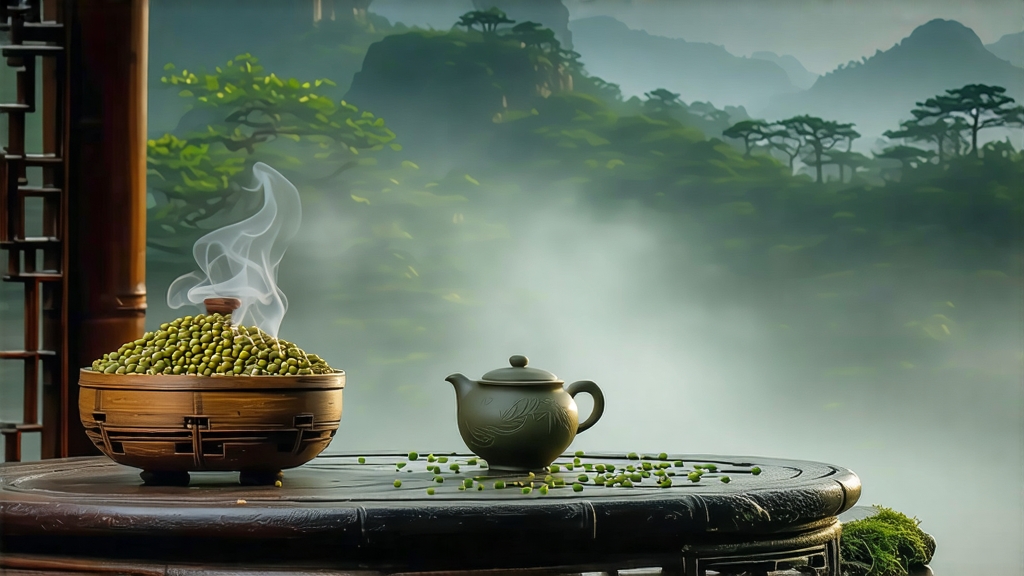
Tucked into the cloud-laced ridges of Sichuan’s Meng Ding range, Meng Ding Huang Ya—“the yellow bud from the summit of Meng”—has been whispered about in Chinese tea lore since the Tang dynasty. Imperial annals record that it reached the palace in Xianyang as early as 724 CE, packed in thin wax-paper cylinders inside bamboo tubes sealed with tung oil so that the fragrance would survive the three-week journey down the Min River. For more than a millennium it remained an aristocratic secret, overshadowed by greener cousins such as Long Jing or Bi Luo Chun. Only in the last two decades, as Chinese tea historians revisited half-forgotten tribute lists, has Meng Ding Huang Ya re-emerged, giving the world a chance to taste the mellow, golden cup that once greeted Tang emperors at dawn court sessions.
Meng Ding itself is a narrow granite spine rising abruptly above the Chengdu plain. At 1 450 m the air is cool even in July; morning fog lingers until noon, filtering sunlight into a soft, even glow. The soil is a loose, slightly acidic yellow loam rich in quartz and humus, the legacy of ancient glaciers. Wild camphor and gingko trees interlace the tea gardens, their roots exchanging aromatic resins with the shallow-rooted tea bushes. These ecological details are not romantic footnotes: they explain why the raw leaf already carries a faint orchid note before any human hand touches it.
Strictly speaking, Meng Ding Huang Ya is not a single cultivar but a seasonal selection from three local seed-grown bushes—xiao ye zhong (“small-leaf ancestor”), bai hao zao (“white-down early”), and the even rarer shui xian bai (“narcissus white”). Garden managers still follow the Ming-era rule “three hundred buds to the liang,” meaning roughly 37 000 tender tips are needed for one traditional 500 g parcel. Plucking begins on the first day after Grain Rain when each bud stands at 12–15 mm, still sheathed in down and curved like a sparrow’s tongue. Experienced pickers pinch at the hypocotyl, never pulling, so the dormant auxiliary bud remains intact for next flush. A full day’s harvest by a four-person crew fills only one shallow bamboo basket lined with fresh banana leaf, preventing compression bruises.
The magic of yellow tea lies in the “sealed yellowing” step, a controlled oxidation that occurs without enzymatic browning. At the Meng Ding state-owned workshop, the morning’s pick is first spread under a reed-mat awning for three hours of withering; moisture drops from 76 % to 68 %. Next comes a two-minute sha qing (“killing-green”) in a drum heated to 140 °C. The goal is not full deactivation—about 12 % polyphenol oxidase must survive—so the operator judges by ear: when the rustling leaf sounds like dry beans in a gourd, he jerks the release gate. Immediately the hot leaf is piled 8 cm deep inside a cedar box whose interior has been smoked over Tibetan juniper. A damp cloth covers the pile; every 30 minutes a master inserts a slender mercury thermometer, maintaining 38–42 °C for four hours. During this sauna the buds slowly suffocate, chlorophyll degrades into pheophytin, and catechins dimerize into theaflavins, yielding the characteristic straw-gold liquor. Finally the leaf is hand-rubbed along a bamboo screen to set the shape, then dried in three passes: 80 °C for aroma fixation, 60 °C for moisture equalization, and 50 °C for the “foot-fire” that locks in sweetness. Total processing time: 26 attentive hours.
The finished tea is visually unmistakable: straight, slightly hooked buds the color of antique parchment, each tipped with a pale down that glints under light. Ten grams occupy an entire gaiwan; they feel almost weightless, like moth wings. The dry scent is subtle—dried apricot, wet slate, a trace of camphor—but once awakened by warm air the bouquet expands into honeyed pear, narcissus, and a whisper of sandalwood that many Western drinkers liken to fine Sauternes.
To brew Meng Ding Huang Ya Western writers often recommend a glass cylinder and 80 °C water, yet local artisans insist on gongfu discipline. A 120 ml zisha or porcelain gaiwan is ideal; pre-heat until too hot